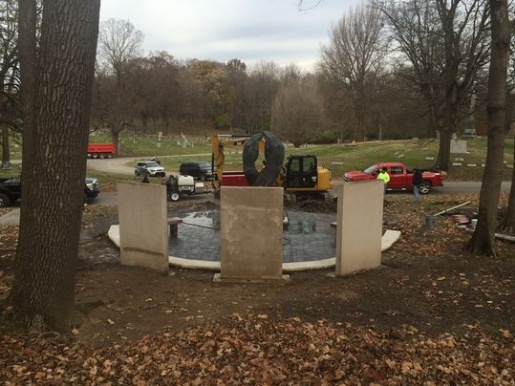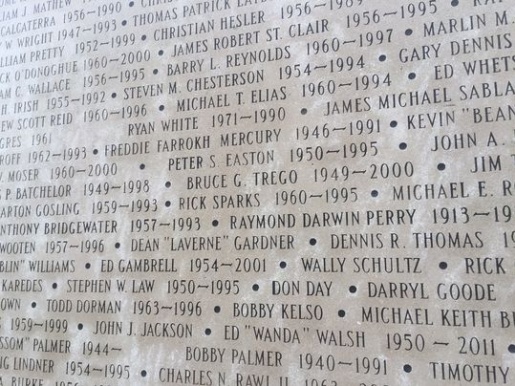

|
Indianapolis, IN United States |
Crown Hill Cemetery, 700 West 38th Street, Northeast corner of section 90 | Indiana AIDS Memorial |
since 29 October 2000 138 names |
The Indiana AIDS Memorial is getting a major renovation just in time for World AIDS Day, when it will be rededicated. World AIDS Day is Dec. 1. The rededication ceremony starts at 9 a.m. at the memorial, which is nestled among trees at the base of a hill in Crown Hill Cemetery.
When it was erected, in 2000, the monument was one of only four in the U.S. dedicated to those who died of HIV/AIDS. It went up at a cost of about $100,000 shortly after San Francisco's, Los Angeles' and Key West's AIDS monuments and ahead of New York's.
This week the monument got a $75,000 overhaul, which included the addition of a low semi-circular wall and large circular base of stamped concrete around the monument's centerpiece sculpture as well as a sidewalk leading to it from the cemetery road, improvements that should make the memorial more inviting. "The ground up around it could get muddy," said Jason Grisell, president and CEO of the Health Foundation of Greater Indianapolis, one of the project's chief funders.
The memorial's centerpiece is Indianapolis artist Guy R. Grey's 10-foot bronze of two crossed arms meeting at the hands. It resembles the familiar shape of the AIDS lapel ribbon. Behind it are three large stone tablets. One lists the project's donors. The other two tablets have been disappointing. They were installed with the idea that the names of Hoosiers who died of AIDS, for a $100 fee, would be inscribed on them. But in the 17 years since, only 138 names have been inscribed, enough to fill about 75 percent of one tablet. One of those names is Ryan White. The other tablet remains blank. And not all of the 138 names are local. One inscription is "Freddie Farrokh Mercury." He was the lead singer of the English rock band Queen, who died of AIDS in 1991.
Between 1981 and 2016 there were 6,796 AIDS deaths in Indiana, according to the Indiana State Department of Health's count, "and it's presumed that could be low because some AIDS-related deaths might not have been coded correctly," said Grissell. "We hope to get more names" on the tablets, said Keith Norwalk, president of Crown Hill Cemetery, "not for the money but to increase awareness." Norwalk, who in 2000 besides his job at the cemetery was president of the Indiana AIDS Fund, said that the memorial initially "was not really embraced by the community, including some of the gay community, because this was a time when (AIDS) was something to hide under the rug." (Even the flamboyant Freddie Mercury did not concede the truth of the rumors his AIDS until the week he died.)
Local AIDS activists tried to organize an annual run/walk through the cemetery to benefit AIDS. "But it didn't take off," Norwalk said. "We did it just the one year. But today we're in a different world, a world where AIDS is an illness not an epidemic, an illness that's being dealt with, so it's not necessarily a death knell."
Following advances in medicine, people diagnosed with the HIV virus live on average between just one and two years fewer than people without it, Grissell said. In 2016 there were 4,986 people living with HIV/AIDS in Marion County, according to the state health department, and 52 deaths. The Indiana AIDS Memorial is these days less about illness and more about AIDS-awareness activists' political struggle to gain funding for research that could combat the disease, Norwalk and Grissell said.
"The new generations never experienced what we did back then," said Norwalk, 69, "and for them this is a reality check. It's not to create fear, but to create education and awareness." "Some of the folks who lived through the crisis want to make sure history is not forgotten," said Grissell, "especially from a social justice perspective. A lot of names on the memorial died too early because of stigma within their families and the healthcare system."
Photos (c) Will Higgins IndyStar
28 November 2017
Will Higgins, Indianapolis



















